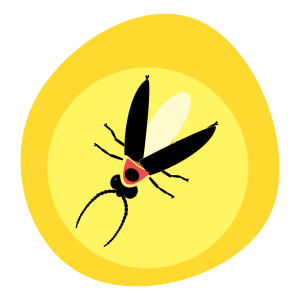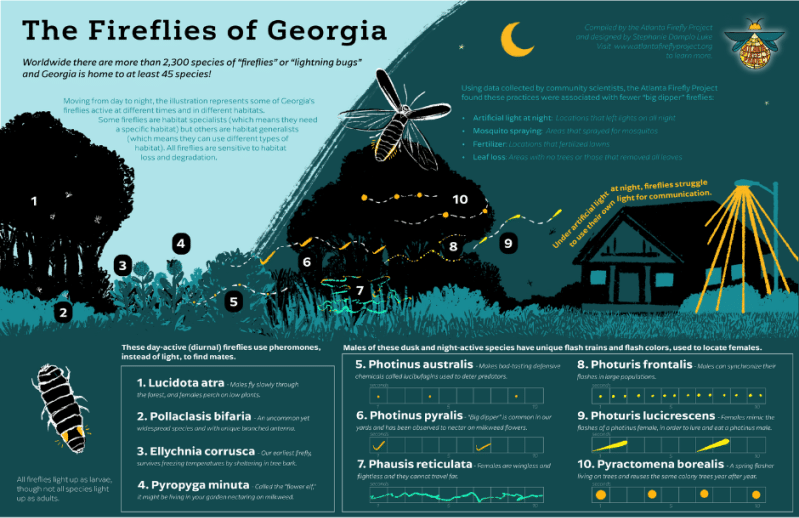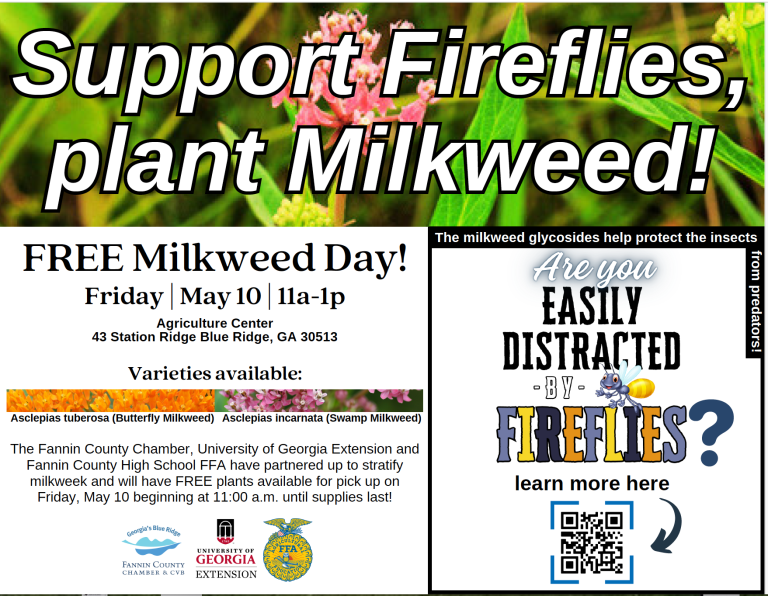Lights Off. Fireflies On.
Everyone can play a role in protecting our fireflies!
“Georgia has incredible diversity of habitat, plants and wildlife, including high numbers of firefly (lightning bug) species. In addition to many less obvious night time and daytime lighting bugs, in the correct dark setting, North Georgia has spectacular displays of certain species like Snappy Syncs, the Smokies Syncs, the Christmas Lights, Blue Ghosts and Big Dippers; and interestingly, has several extremely rare species, Loopy 5s and Pointy Lobed, which experts are still discovering and documenting.” – Lynn Faust, Firefly expert and consultant to many state and national parks
Did you know that fireflies consume parts of the milkweed plant (Asclepias spp.)? Scientists believe they use the milkweed’s cardiac glycosides as a protection against predators. Once a predator attempts to eat a firefly that contain these chemical compounds, the predator realizes it is distasteful and won’t attempt to attack another firefly. More information can be found in this research article by Lynn and Hugh Faust.
Students from Fannin County High School and Fannin County Middle School learned the skill of stratifying seeds. They stratified and grew out milkweed plants as a community project. If you are in the Blue Ridge, Georgia, area on May 10th, come by and pick up a free plant.
Help fireflies by planting milkweed!
Fascinating Firefly Facts

- Fireflies are not really flies but are beetles in the Lampyridae (meaning “lamp”) family.
- Firefly flashes are the result of a chemical reaction that happens in an organ under the insect’s abdomen.
- Most of a firefly’s lifecycle is spent in the larval phase. Firefly larvae are predators of soft-bodied invertebrates like slugs and they like a habitat of leaf litter and downed trees.
- Over 2,000 firefly species are found around the world on every continent except Antarctica.
- In most species, the female fireflies don’t fly. They perch on high grasses waiting for a mate.
- The most common firefly in Georgia is the Big Dipper (Photinus pyralis) which moves in a J-shaped flight path.
- On average adult fireflies live for just a few weeks.
- Information on our most common firefly – the Big Dipper (Photinus pyralis)
What can YOU do for fireflies:

Create firefly habitat.
Set aside natural areas of your landscape that include leaf litter, rotting logs and unmowed vegetation. Plant native trees, shrubs and grasses of varying heights. Protect and enhance moisture in your landscape or create a water feature.
Eliminate unnecessary night lighting.
Artificial night light interferes with the fireflies ability to communicate and find a mate. Turn outdoor lights off at night. Take steps to reduce the effects of lighting that must stay on. Use light shields or red light bulbs. Consider making your home dark sky friendly.
Make memories.
Fireflies are one of our most cherished symbols of summer. Spend time outside on summer evenings enjoying the firefly show Learn about the different species in your area and spread the word about firefly conservation.

Becky Griffin, UGA Extension, sat down with firefly expert, Lynn Faust, to talk about Faust’s experience in researching fireflies and the wonder of North Georgia lightning bugs!
For More Information:
- Enthusiastic fireflyers are encouraged to enter their sightings in the Xerces Society Firefly Atlas
- University of Georgia created a firefly fact card.
- The book Fireflies, Glow-worms, and Lightning Bugs by Lynn Frierson Faust is a fantastic resource for firefly enthusiasts.
- Visit darksky.org for tips on minimizing harmful outdoor lighting.
- Work towards making your landscape firefly certified at firefly.org.
- If you live near Atlanta, consider participating in the Atlanta Firefly Project .
- Firefly Conservation: A Guide to Protecting the Jewels of the Night is a small booklet published by the Xerces Society.
- The Great Smoky Mountains National Park is home to the Synchoronous Fireflies (Photinus carolinus). The park holds a popular lottery allowing only a restricted number of viewers to watch the fireflies flash.

Firefly Photo Gallery:
For more information, contact Becky Griffin (beckygri@uga.edu) at University of Georgia Extension.

The University of Georgia College of Agricultural and Environmental Sciences (working cooperatively with Fort Valley State University, the U.S. Department of Agriculture, and the counties of Georgia) offers its educational programs, assistance, and materials to all people without regard to race, color, religion, sex, national origin, disability, gender identity, sexual orientation or protected veteran status and is an Equal Opportunity, Affirmative Action organization.
